Brain Implant Market Research, 2032
The global brain implant market size was valued at $1.4 billion in 2022, and is projected to reach $4.5 billion by 2032, growing at a CAGR of 12.2% from 2023 to 2032. A medical device called brain implant is surgically inserted into the brain to monitor or regulate brain activity. They are intended to aid people with neurological illnesses or traumas in regaining lost function or improving their quality of life. Moreover, there are various types of brain implant, each with a distinct function. Neurological illnesses such as Parkinson's disease, epilepsy, and Alzheimer's disease are treated with some types of brain implant. To relieve symptoms, these implants operate by sending electrical impulses to particular parts of the brain.
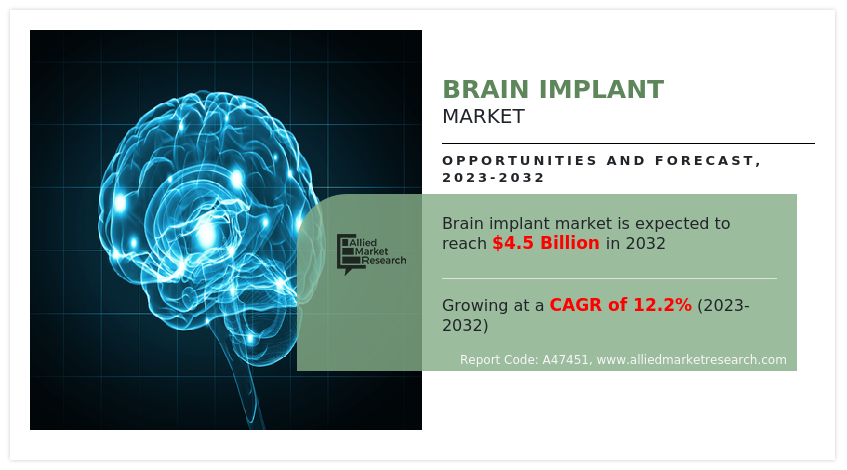
Market Dynamics
Rise in prevalence of old age population that is more vulnerable to epilepsy and Parkinson’s is the major key factor driving the market growth. For instance, according to an article published by UpToDate Inc., in August 2021, the incidence rate of epilepsy increased with age and is highest in patients over 75 years of age. Thus, rise in prevalence of epilepsy among geriatric population drives the demand for brain implant devices to treat and manage the disease.
In addition, upsurge in demand for minimally invasive devices. Patients are increasingly seeking treatments that offer higher success rates, less pain, and long-term effectiveness, all of which are benefits provided by brain implant. As a result, the demand for these implants is expected to increase, leading to a boost in market growth. Furthermore, key players in the industry are investing heavily in research and development activities, driving innovation and the introduction of advanced brain implant devices. These devices are designed to provide even greater efficiency and improved outcomes for patients, which is expected to further drive the demand and growth of the brain implant market opportunity.
In addition, manufacturers of brain implant are expanding their operations globally, launching their products in various regions worldwide.This is expected to increase market penetration, improve accessibility, and drive demand for brain implant across different regions. The growth of the brain implant market is expected to be driven by the availability of improved healthcare infrastructure, rise in prevalence of neurological diseases such as epilepsy and depression. Furthermore, the healthcare industry in developed economies is growing at a significant rate, owing to rise in demand for enhanced healthcare services, significant investments by government to improve healthcare infrastructure.
Moreover, the demand for brain implant is not only limited to developed countries but is also being witnessed in the developing countries, such as China and Brazil, which fuel the growth of the market. Further, rise in adoption of long term efficiency implants, as patients seek treatment options that offer long-term benefits, such as improved cognitive function, pain relief, and reduced symptoms, the demand for brain implant is expected to rise.
In addition, there has been an increase in awareness toward early diagnosis and treatment of neurological disorders, which is another factor driving the growth of the brain implant market. Early diagnosis enables patients to seek timely treatment, leading to improved outcomes and increased chances of recovery. As awareness around these issues continues to grow, more patients are likely to seek brain implant treatments as a viable option for managing their conditions, leading to further growth of the market. Furthermore, increase in promotional activities by manufacturers and government organizations for availability of advanced brain implant devices among the general population are expected to fuel their adoption in the near future.
However, stringent government regulations on manufacturing of medical devices for maintaining the quality and safety of the device delays the product approvals thereby restraining the market growth. In addition, different governments often adopt varying regulations, which can further complicate the clearance process for manufacturers seeking to market their products internationally. Furthermore, the high cost of brain implant devices can also pose a challenge to the growth of the brain implant market.
The outbreak of COVID-19 has disrupted workflows in the health care sector around the world. The disease has forced a number of industries to shut their doors temporarily, including several sub-domains of health care. The global brain implant devices market experienced a decline in 2020 due to global economic recession led by COVID-19. In addition, the COVID-19 outbreak disrupted the supply chain across various end-user industries like healthcare and manufacturers.
However, the market is anticipated to witness recovery and show stable growth for brain implant market in the coming future. This is attributed to the increase in adoption of advanced brain implant and augmentation in demand for advanced manufacturing systems. In addition, article published by National Library of Medicine (NIH) 2023, stated that, post-COVID prevalence of neuropathic pain is estimated to be 24.4% in patients affected with COVID 19. Thus, prevalence of chronic conditions and rise in regular check-ups to manage neurological symptoms are expected to have significant impact on adoption of various types of brain implant devices in upcoming years.
Segmental Overview
The brain implant market is segmented segmented into type, application, end user, and region. By type, the market is categorized into deep brain stimulation and vagus nerve stimulation. By application, the market is classified into Parkinson’s disease, epilepsy and others. By end user, the market is divided into hospitals, neurology clinics and others. Region wise, the market is analyzed across North America (U.S., Canada, and Mexico), Europe (Germany, France, UK, Italy, Spain, and rest of Europe), Asia-Pacific (Japan, China, India, Australia, South Korea, and rest of Asia-Pacific), and LAMEA (Brazil, South Africa, Saudi Arabia, and rest of LAMEA).
By Type
The brain implant market is segmented into the market is classified into deep brain stimulation and vagus nerve stimulation. The deep brain stimulation segment accounted for largest brain implant market share in 2022 and is also expected to witness highest CAGR during the forecast period, owing to rise in number of people suffering from parkinsons and tremors. In addition, implanted DBS devices are effective in treating parkinsons and tremors by sending electrical impulses to the brain to regulate abnormal brain activity that causes the symptoms of these movement disorders. Thus, reducing the perceptions of tremors and improving a patient's quality of life, further supports the segment growth.
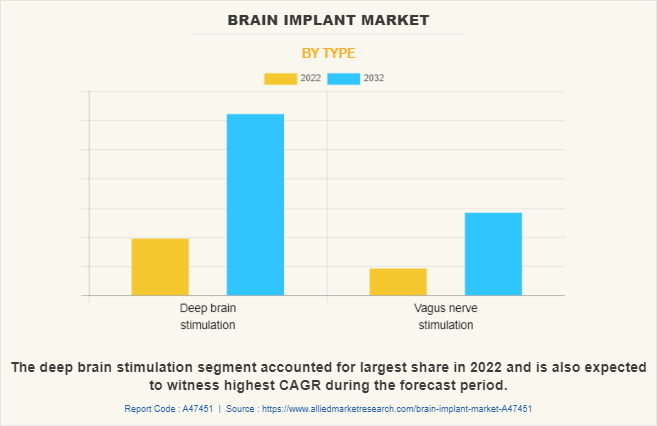
By Application
The brain implant market is divided into application, the market is divided into Parkinson’s disease, epilepsy and others. The Parkinson’s disease segment accounted for the largest brain implant market share in 2022 and is also expected to witness highest CAGR during the forecast period. This is attributed to a rise in prevalence of Parkinson’s in adults and geriatric population.
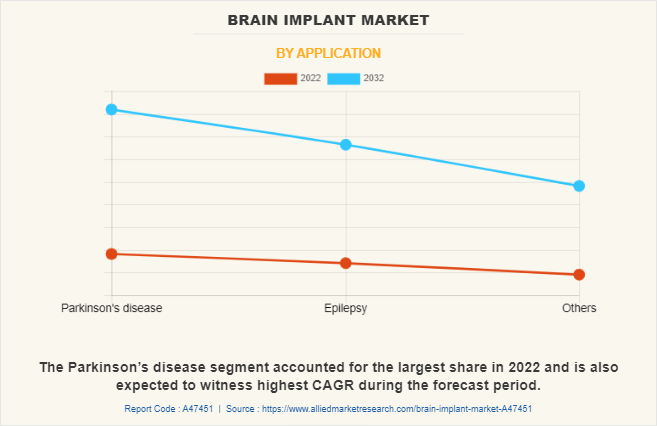
By End User
The brain implant market is classified into hospitals, neurology clinics and others. The hospitals segment dominated the brain implant market size in 2022 and is expected to remain dominant during the forecast period owing to increase in patient admission in hospital and availability of trained medical staff in hospitals that help to provide better services to patients, increase in geriatric population that are more prone to neurological disease and rise in healthcare expenditure.
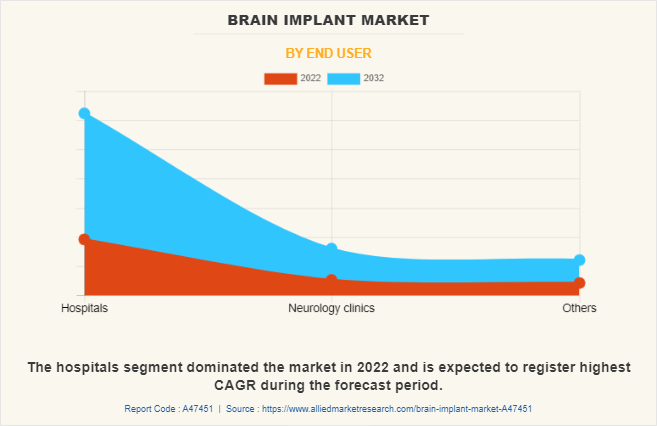
By Region
The brain implant industry is analyzed across North America, Europe, Asia-Pacific, and LAMEA. North America was the largest shareholder in the global brain implant market in 2022, owing to increase in target diseases such as Parkinson’s and epilepsy, high availability of advanced brain implant, presence of well-developed healthcare infrastructure and favorable reimbursement policies in healthcare systems drives the market growth in this region. However, Asia-Pacific is anticipated to register the highest CAGR during the brain implant market forecast, owing to a rise in geriatric population, rise in prevalence of neurological diseases and rise in awareness about advantage of brain implant such as long-term efficacy, is driving the market growth.
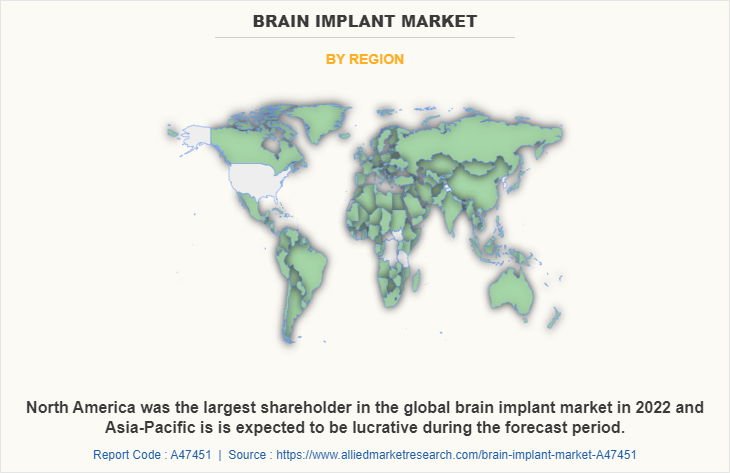
Rise in technological advancement in brain implant have led to the development of MRI-compatible devices, which allow patients to undergo MRI scans without removing or damaging their implant. Thus, rise in such technological advancements and presence of market key players offering such brain implant further drives the brain implant market growth. In addition, the presence of well-established healthcare infrastructure, high purchasing power, and rise in adoption rate of brain implant are expected to drive the market growth.
Moreover, shift from traditional medication to electrical stimulation of nerves has been pivotal in development of new treatment options for different applications which supports the market growth. Asia-Pacific is expected to grow at the highest rate during the forecast period. The market growth in this region is attributable to presence of medical device companies in the region as well as growth in the purchasing power of populated countries, such as China and India. Moreover, adoption of high-tech processing to improve the production of medical devices drives the growth of the brain implant market.
Asia-Pacific offers profitable opportunities for key players operating in the brain implant industry, thereby registering the fastest growth rate during the forecast period, owing to the rise in prevalence of depression, Parkinson’s and epilepsy, as well-established presence of domestic companies in the region. In addition, rise in contract manufacturing organizations within the region provides great opportunity for new entrants in this region.
Competition Analysis
Competitive analysis and profiles of the major players in the brain implant industry, such as Abbott Laboratories, Aleva Neurotherapeutics SA, Boston scientific corporation, Functional Neuromodulation Ltd., Medtronic plc, NeuroPace Inc., Beijing PINS Medical Co., Ltd, LivaNova PLC., MicroTransponder Inc. and SceneRay Co., Ltd are provided in this report. Key players have adopted product launch and product approval from regulatory bodies as key developmental strategies to improve the product portfolio of the brain implant market.
Recent Product Launch in the Brain Implant Market
- In February 2023, LivaNova PLC, a market-leading medical technology and innovation company, announced the launch of SenTiva DUO, an implantable pulse generator (IPG) with a dual-pin header to provide VNS Therapy for the treatment of drug-resistant epilepsy.
- In February 2019, Medtronic plc, a global leader in healthcare technology, announced U.S. Commercial Launch of Deep Brain Stimulation for Medically-Refractory Epilepsy.
Recent Product Approval in the Brain Implant Market
- In January 2020, Abbott, one of the global healthcare leaders, received the U.S. Food and Drug Administration (FDA) approval for Infinity DBS Neurostimulation System, used in the treatment of Parkinson disease.
- In September 2022, Aleva Neurotherapeutics SA, pioneered Directional Deep Brain Stimulation (DBS) in Neuromodulation, received CE approval for its MRI labeling of the directSTIM DBS System, to be used in a full-body magnetic resonance imaging (MRI) environment.
Key Benefits For Stakeholders
- This report provides a quantitative analysis of the market segments, current trends, estimations, and dynamics of the brain implant market analysis from 2022 to 2032 to identify the prevailing brain implant market opportunities.
- The market research is offered along with information related to key drivers, restraints, and opportunities.
- Porter's five forces analysis highlights the potency of buyers and suppliers to enable stakeholders make profit-oriented business decisions and strengthen their supplier-buyer network.
- In-depth analysis of the brain implant market segmentation assists to determine the prevailing market opportunities.
- Major countries in each region are mapped according to their revenue contribution to the global market.
- Market player positioning facilitates benchmarking and provides a clear understanding of the present position of the market players.
- The report includes the analysis of the regional as well as global brain implant market trends, key players, market segments, application areas, and market growth strategies.
Brain Implant Market Report Highlights
| Aspects | Details |
| Market Size By 2032 | USD 4.5 billion |
| Growth Rate | CAGR of 12.2% |
| Forecast period | 2022 - 2032 |
| Report Pages | 250 |
| By Type |
|
| By Application |
|
| By End User |
|
| By Region |
|
| Key Market Players | NeuroPace, Inc., MicroTransponder Inc., Medtronic plc, Boston Scientific Corporation, LivaNova PLC, Beijing PINS Medical Co., Ltd, Abbott Laboratories, SceneRay Co., Ltd., Functional Neuromodulation, Ltd., Aleva Neurotherapeutics SA |
Analyst Review
This section provides various opinions in the global brain implant market. The global brain implant market is expected to exhibit high growth potential due to rise in demand for management of neurological disorders with long-term efficacy. In addition, increase in geriatric population suffering from neurological diseases such as, Parkinson’s and epilepsy leads to high adoption of brain implant, which is expected to significantly boost the growth of the brain implant market. However, high maintenance and device costs restrain the adoption of brain implant and lack of skilled professionals hinder the market growth.
Further, increase in awareness regarding advantages of implantable devices is anticipated to drive the market growth. Furthermore, North America was the major shareholder in 2022, in terms of revenue, owing to rise in incidences of Alzheimer's cases, higher health awareness, and developed healthcare infrastructure in the region. However, Asia-Pacific is anticipated to witness notable growth, owing to an increase in number of target population, along with surge in awareness of early detection of disease.
The total market value of brain implant market is $1,426.00 million in 2022.
The market value of brain implant market in 2032 is $4,529.95 million in 2032.
The forecast period for brain implant market is 2023 to 2032.
The base year is 2022 in brain implant market.
Top companies such as Abbott Laboratories, Boston scientific corporation, Medtronic plc, and Beijing PINS Medical Co., held a high market position in 2022. These key players held a high market position owing to the strong geographical foothold in North America, Europe, Asia-Pacific, and LAMEA.
The deep brain stimulation segment is the most influencing segment in brain implant market owing to rise in number of people suffering from Parkinson’s and tremors.
A brain implant, also known as a neural implant, is a device that is surgically implanted into the brain to provide therapeutic benefits or augment cognitive or sensory functions.
The brain implant are used to treat neurological disorders such as epilepsy, Parkinson’s disease, and Alzheimer's disease, or to restore functions in individuals who have suffered a brain injury or stroke.
Loading Table Of Content...
Loading Research Methodology...


